Related Research Articles

Alfred Tennyson, 1st Baron Tennyson was an English poet. He was the Poet Laureate during much of Queen Victoria's reign. In 1829, Tennyson was awarded the Chancellor's Gold Medal at Cambridge for one of his first pieces, "Timbuktu". He published his first solo collection of poems, Poems, Chiefly Lyrical, in 1830. "Claribel" and "Mariana", which remain some of Tennyson's most celebrated poems, were included in this volume. Although described by some critics as overly sentimental, his verse soon proved popular and brought Tennyson to the attention of well-known writers of the day, including Samuel Taylor Coleridge. Tennyson's early poetry, with its medievalism and powerful visual imagery, was a major influence on the Pre-Raphaelite Brotherhood.

Stigand was an Anglo-Saxon churchman in pre-Norman Conquest England who became Archbishop of Canterbury. His birth date is unknown, but by 1020 he was serving as a royal chaplain and advisor. He was named Bishop of Elmham in 1043, and was later Bishop of Winchester and Archbishop of Canterbury. Stigand was an advisor to several members of the Anglo-Saxon and Norman English royal dynasties, serving six successive kings. Excommunicated by several popes for his pluralism in holding the two sees, or bishoprics, of Winchester and Canterbury concurrently, he was finally deposed in 1070, and his estates and personal wealth were confiscated by William the Conqueror. Stigand was imprisoned at Winchester, where he died.
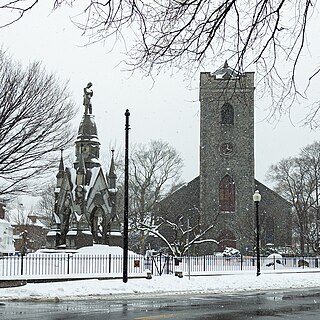
Jamaica Plain is a neighborhood of 4.4 square miles (11 km2) in Boston, Massachusetts. Settled by Puritans seeking farmland to the south, it was originally part of Roxbury, Massachusetts. The community seceded from Roxbury during the formation of West Roxbury in 1851 and became part of Boston when West Roxbury was annexed in 1874. In the 19th century, Jamaica Plain became one of the first streetcar suburbs in America and home to a significant portion of Boston's Emerald Necklace of parks, designed by Frederick Law Olmsted.

Brookland, also known as Little Rome or Little Vatican, is a neighborhood located in the Northeast (NE) quadrant of Washington, D.C. It is best known for its numerous Catholic institutions, including schools, religious communities, shrines, institutes, and other organizations built and based around the Catholic University of America.

Peter Stephen Kalikow is president of H. J. Kalikow & Company, LLC, a New York City-based real estate firm. He is a former chairman of the Metropolitan Transportation Authority (MTA), former commissioner of the Port Authority of New York and New Jersey and past owner and publisher of the New York Post.
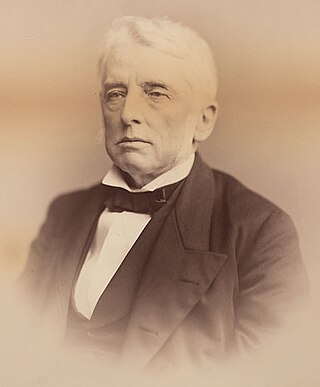
John Cadwalader was an American lawyer, jurist, and politician who served as a United States representative from Pennsylvania and a United States district judge of the United States District Court for the Eastern District of Pennsylvania.

Drayton Manor, one of Britain's lost houses, was a British stately home at Drayton Bassett, since its formation in the District of Lichfield, Staffordshire, England. In modern administrative areas, it was first put into Tamworth Poor Law Union and similar Rural Sanitary District, 1894 to 1934 saw its inclusion in Tamworth Rural District, and in the next forty years it lay in the 1974-abolished Lichfield Rural District.
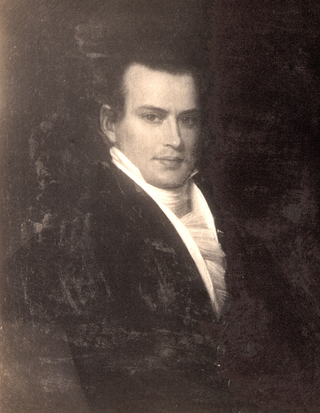
William Cabell Rives was an American lawyer, planter, politician and diplomat from Virginia. Initially a Jackson Democrat as well as member of the First Families of Virginia, Rives served in the Virginia House of Delegates representing first Nelson County, then Albemarle County, Virginia, before service in both the U.S. House and Senate. Rives also served two separate terms as U.S. Minister to France. During the Andrew Jackson administration, Rives negotiated a treaty whereby the French agreed to pay the U.S. for spoliation claims from the Napoleonic Wars. During the American Civil War, Rives became a Delegate to the Provisional Confederate Congress and the Confederate House of Representatives.
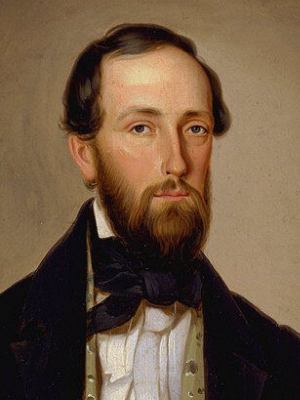
Rodman McCamley Price was an American naval officer, businessman, and Democratic Party politician who served as the 17th Governor of New Jersey from 1854 to 1857. He also worked to establish the American government in California and served on the first San Francisco City Council, where he became a real estate tycoon. He represented New Jersey in the United States House of Representatives for one term from 1851 to 1853.
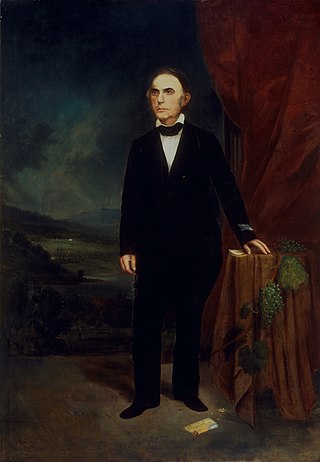
The Longworth family is most closely associated with Cincinnati, Ohio, and was one of Cincinnati's better-known families during the 19th and 20th centuries. The founder of the Ohio family, Nicholas Longworth, came to Cincinnati from Newark, New Jersey, sometime before 1808. He married Susanna Howell, three years his junior, daughter of Silas and Hannah (Vaughan) Howell, on Christmas Eve, 1807.

Ospringe is a village and area of Faversham in the English county of Kent. It is also the name of a civil parish, which since 1935 has not included the village of Ospringe.

James Brown Clay was an American politician and diplomat who served as a member of the United States House of Representatives for Kentucky's 8th congressional district from 1857 to 1859.

Thomas Jefferson Randolph of Albemarle County was a Virginia planter, soldier and politician who served multiple terms in the Virginia House of Delegates, as rector of the University of Virginia, and as a colonel in the Confederate Army during the American Civil War. The favorite grandson of President Thomas Jefferson, he helped manage Monticello near the end of his grandfather's life and was executor of his estate, and later also served in the Virginia Constitutional Convention of 1850 and at the Virginia Secession Convention of 1861.
Thomas Henry Bayly was a nineteenth-century politician, slave owner, lawyer and judge from Virginia, and the son of Congressman Thomas M. Bayly.
Charles Brooks Smith was a Union Army veteran, businessman and Republican politician who served in the United States House of Representatives for a single term from West Virginia's 4th congressional district.
The McCormick family of Chicago and Virginia is an American family of Scottish and Scotch-Irish descent that attained prominence and fortune starting with the invention of the McCormick Reaper, a machine that revolutionized agriculture and established the modern grain trade by beginning the mechanization of the harvesting of grain. Through the McCormick Harvesting Machine Company and later, the International Harvester Company and other investments, the McCormicks became one of the wealthiest families in America. The name became ubiquitous in agriculture starting in the 19th century and the press dubbed the McCormicks the "Reaper Kings". Later generations expanded into media and publishing, finance, and real estate. Various family members were well known as civic leaders. They are descended from an influential leader of modern agriculture, inventor Robert McCormick Jr. (1780–1846), and Mary Ann "Polly" Hall of Steeles Tavern, Virginia. The family is Presbyterian.

Ernest Brooks was a British photographer, best known for his war photography from the First World War. He was the first official photographer to be appointed by the British military, and produced several thousand images between 1915 and 1918, more than a tenth of all British official photographs taken during the war. His work was often posed and formal, but several of his less conventional images are marked by a distinctive use of silhouette. Before and immediately after the war he worked as an official photographer to the Royal Family, but was dismissed from this appointment and stripped of his official honours in 1925, for reasons that were not officially made public.
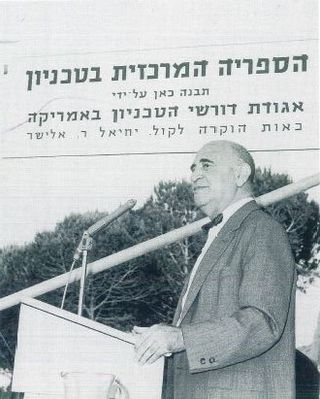
Jehiel Raphael Elyachar was an engineer, real estate developer and philanthropist who contributed to American and Israeli causes. He distinguished himself during World War II as a colonel in charge of military intelligence for the United States Army, earning the Bronze Star Medal, the Legion of Merit, and the Légion d'honneur.

Brooks Mansion is a Greek Revival plantation house and Category II Landmark. It is located at 901 Newton Street, Northeast, Washington, D.C., in the Brookland neighborhood, next to the Brookland–CUA.
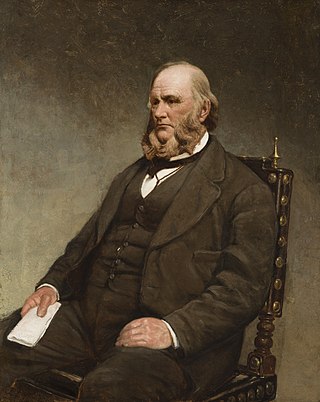
Joseph Longworth was an American lawyer, real-estate magnate, art collector, and philanthropist. A member of the wealthy Longworth family, he helped shape cultural life in Cincinnati for a generation. Longworth sold the parcel of land that would become Eden Park, including the land that would be used for the Cincinnati Art Museum. He also contributed to the construction of the museum and served as its first president. Longworth was the "prime mover" for the Art Academy of Cincinnati, arranging the movement of the school to Eden Park, planning its integration with the museum, and endowing it with $370,000. In 2013 the original Art Academy building was renamed the Longworth Wing of the Cincinnati Art Museum in his honor.